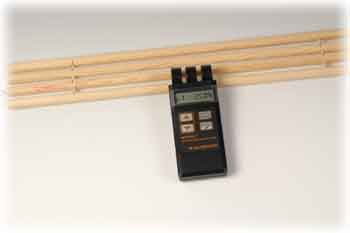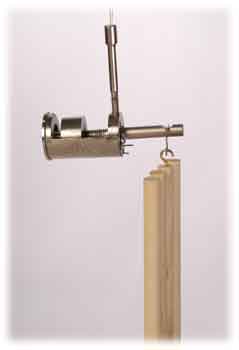
Mary Ann Davies, Project Leader,
and Connie McMichael,
Electronic Technician
Estimating the moisture content of dead woody fuels is critical when predicting fire behavior. In general, drier fuels increase the rate of fire spread, fireline intensity, and fuel consumption.
Prescribed burns are used to meet a number of resource management objectives. Fire managers rely on fire behavior prediction to determine the optimum conditions for prescribed burning.
Dead fuels are divided into four size classes: 1 hour (flashy fuels), 10 hour (½-inch diameter), 100 hour (3-inch diameter) and 1,000 hour (8-inch diameter). In general, the larger fuels take longer to absorb or lose moisture.
Highlights...
- Fuel moisture sticks are widely used to measure fuel moisture, which
can help fire managers predict fire behavior.
- Seven portable fuel
moisture meters and scales were evaluated.
- The most accurate instruments evaluated were the Pesola Medio-Line spring scale, the Pocket Firestick Moisture Scale, and the Forester Fuel Moisture Scale, Chisholm model (no longer available).
A fuel moisture stick (figure 1) is used as a substitute for natural fuels when calculating the moisture content of dead fuels in the 10-hour fuel moisture class. These four connected ½-inch-diameter ponderosa pine dowels are manufactured to specific tolerances with an ovendried weight of about 100 grams.

Figure 1—A 10-hour fuel moisture stick
(four connected ponderosa pine
dowels)
is the standard used to estimate the
moisture in 10-hour dead fuels.
For optimal prescribed burning conditions, the moisture content of the 10-hour fuel moisture sticks should range from 8 to 17 percent for most locations. If the moisture content is too low, prescribed burns can become intense and erratic, and fire effects may be too severe. If the moisture content is too high, too little fuel may be burned.
Traditionally, several 10-hour fuel moisture sticks were set out at the site until their moisture reached equilibrium with the ambient environmental conditions. Once a day, field personnel would retrieve and weigh the fuel moisture sticks, typically using a mechanical arm scale calibrated with a 100-gram weight.
Once a fuel moisture stick reaches equilibrium, its moisture content should be similar to that of natural fuels of the same size. The fuel moisture stick's initial dry weight (usually 100 grams) subtracted from its weight in ambient conditions yields the weight of water in grams. Because the fuel moisture stick weighs about 100 grams when ovendried, the difference in weight also equals the percent fuel moisture.
Now, fire managers can choose from a variety of instruments when measuring fuel moisture. Some managers measure the moisture content of dead woody fuels using electronic pin and surface contact meters. Other managers still rely on the 10-hour fuel moisture sticks, using mechanical arm and spring scales to measure fuel moisture.
No matter what instrument fire managers use to measure fuel moisture, they should routinely check the instrument's accuracy. The best check is to weigh a fuel moisture stick on an accurate tabletop scale and compare the results to those of the instrument. The Missoula Technology and Development Center (MTDC) evaluated seven different portable fuel moisture meters and scales (table 1) to determine their accuracy.
| Delmhorst J–2000 | |
|---|---|
| Display and Type: | Digital LCD, embedded pin |
| Range: | 6 to 40 percent |
| Increments on scale: | 0.1 percent |
| Cost: | $239 |
| Protimeter Mini | |
| Display and Type: | LED light scale, embedded pin |
| Range: | 6 to 28 percent |
| Increments on scale: | 2.0 percent |
| Cost: | $170 |
| Protimeter Mini (Newest model) | |
| Display and Type: | Newest model |
| Range: | 6 to 90 percent |
| Increments on scale: | 1.0 percent |
| Cost: | $170 |
| Holzmeister MoisTest I | |
| Display and Type: | Digital LCD surface contact |
| Range: | 2 to 100 percent |
| Increments on scale: | 0.1 percent |
| Cost: | Available on request |
| Pesola Medio-Line | |
| Display and Type: | Spring scale |
| Range: | 0 to 300 grams |
| Increments on scale: | 2 and 5 grams |
| Cost: | $40 |
| Pocket Firestick Moisture Scale | |
| Display and Type: | Screw micrometer |
| Range: | 0 to 25 percent |
| Increments on scale: | 1/4 gram |
| Cost: | $210 |
| Forester Fuel Moisture Scale, Model 11552 | |
| Display and Type: | Mechanical arm |
| Range: | 0 to 50 percent |
| Increments on scale: | 1.0 percent |
| Cost: | $285 |
| Forester Fuel Moisture Scale, Chisholm model | |
| Display and Type: | Mechanical arm |
| Range: | 0 to 25 percent |
| Increments on scale: | 1.0 percent |
| Cost: | No longer made |
Methods Used in the Evaluation
Two methods were used to condition (adjust the moisture content) fuel moisture sticks. The goal was to condition the fuel moisture sticks from a low of 5 percent to a high of 25 percent moisture content.
In one method, fuel moisture sticks weighing 100 grams (plus or minus 3 grams) were placed in an environmental chamber with constant temperature (70 degrees Fahrenheit) and varying humidity. Using this method, the moisture content never exceeded 12 percent even at the highest humidity setting.
The other method used to condition the fuel moisture sticks was to place them in a water bath for several minutes before removing them and allowing them to dry until they reached the desired weight. The conditioned fuel moisture sticks were weighed on an accurate tabletop scale to obtain their true weight. The moisture content was determined by subtracting the initial dry weight from the conditioned weight. For instance, a 10-hour fuel moisture stick with an initial dry weight of 100 grams and a conditioned weight of 115 grams has 15-percent moisture content. The weights of the conditioned fuel moisture sticks ranged from 105 to 125 grams (5-to 25-percent moisture content).
Instruments EvaluatedPin-type meters (Delmhorst J–2000 and Protimeter Mini) measure the resistance between the two electrode pins embedded into the wood. These instruments were developed primarily for the timber and building industries. Calibration tables correct the results for individual wood species. The Delmhorst J–2000 (figure 2) displays results on a digital LCD readout.

Figure
2—The Delmhorst J–2000 fuel moisture meter.
The Protimeter Mini (figure 3) displays results with a bright LED light next to a moisture scale reading on the instrument. Both instruments use a 9-volt battery. Some districts are using these pin-type meters on dead woody fuels with success. An array of readings from the burn plot can be used to predict whether fuel is gaining or losing moisture to help forecast the burning behavior.

Figure 3—The Protimeter Mini fuel moisture meter.
The Holzmeister MoisTest I (figure 4) is a contact meter that generates an electric field in the wood. This instrument was specifically developed for the wood industry. Calibration tables correct the results for individual wood species. Results are displayed on a digital LCD readout. The instrument uses a 9-volt battery. There are no distributors in the United States, but the instrument can be purchased through the manufacturer in Italy.

Figure 4—The Holzmeister MoisTest I fuel moisture meter.
Mechanical arm scales (Forester Fuel Moisture Scale, Model 11552 and the Chisholm model) operate by zeroing the scale with a 100-gram weight and adjusting a weight mounted on the arm until the dial reads zero. The 100-gram weight is removed and the fuel moisture stick is suspended from the arm to get the moisture content reading. The Forester Fuel Moisture Scale, Model 11552 (figure 5) needs to be mounted on a vertical surface and must be level and plumb for accurate readings.

Figure 5—The Forester Fuel Moisture Scale, Model 11552.
The Chisholm model (figure 6) is easy to hang from a wire suspended from a tree branch. This vintage scale is no longer manufactured, but some districts still use them.

Figure 6—The Forester Fuel Moisture Scale, Chisholm model.
The Pesola Medio-Line (figure 7) is a small, hand-held spring scale. This scale has a zero adjustment and has two scale readings in 2- and 5-gram increments. The fuel stick is suspended from a hook or clamp. Every gram over 100 grams translates directly into percent moisture content.

Figure 7—The Pesola Medio-Line fuel moisture scale.

Enlargement of scale showing 2- and 5-gram increments.
The Pocket Firestick Moisture Scale (figure 8) is a hand-held screw micrometer. Its outer carrying case is used as a 100-gram zero check weight adjustment. Once zeroed, the fuel stick is suspended and the large screw is turned until the arm holding the fuel stick is in a free-floating neutral position. The instrument must be held level for accurate readings.

Figure 8—The Pocket Firestick Moisture Scale.
Thirty-three readings were taken with each of the seven instruments. Each reading was compared to the weight obtained from the tabletop scale. In the 8- to 17-percent fuel moisture range, the most accurate instruments were the Pesola Medio-Line spring scale, the Pocket Firestick Moisture Scale, and the Forester Fuel Moisture Scale, Chisholm model.
The Pesola Medio-Line is very small and easy to use. Its 2-gram increments are close together (figure 7), making it difficult to read the scale. Misreading the scale may cause some error, although the error was below 1 percent for all 33 readings. The Pocket Firestick Moisture Scale also is small and easy to use so long as the instrument is held level. The average error was 2 percent for all 33 readings. The Forester Fuel Moisture Scale, Chisholm model, is easy to use and zero. Readings were 5 percent off when the moisture content was higher than 17 percent. Within the optimum burning range of 8-to 17-percent moisture content, the error was less than 2 percent.
The Delmhorst J–2000 and Protimeter Mini contact pin-type meters performed similarly. The error was about 4 percent. The battery in the Delmhorst J–2000 never lasted more than a few days. Each time it was replaced, the instrument had to be reprogrammed. Otherwise, the readings would not have been correct.
The Holzmeister MoisTest I meter generates an electric field that penetrates the wood. Water droplets on the fuel stick produced large errors that contributed to the overall error of 12 percent for all 33 readings. In the 8-to 17-percent moisture content range, the error was about 8 percent.
The Forester Fuel Moisture Scale, Model 11552, seems to have been based on the Chisholm model. However, Model 11552 has to be mounted level and plumb for accurate readings. This requirement can create some problems when working in the field. This scale is being used by some district personnel with satisfactory results.
In the optimum range of fuel moisture for prescribed burning (8 to 17 percent), errors were as low as 1 percent for the Pesola Medio-Line scale and about 2 percent for the Pocket Firestick Moisture Scale and the Forester Fuel Moisture Scale, Chisholm model (figure 9). The Holzmeister MoisTest I and the Forester Fuel Moisture Scale, Model 11552, produced errors of about 8 percent and 10 percent, respectively.

Figure 9—The average error for 16 fuel moisture readings
by each instrument
in the optimum fuel moisture range for
prescribed burning (8 to 17 percent).
The fuel moisture
content was determined using an accurate tabletop scale and
compared to the readings of each instrument.
Readings in the 18- to 25-percent moisture content range produced errors as low as 1 percent for the Pesola Medio-Line scale to about 18 percent for the Forester Fuel Moisture Scale, Model 11552 (figure 10).

Figure 10—The average error for 12 fuel moisture readings by
each instrument
in the 18- to 25-percent fuel moisture range.
The fuel moisture content was
determined using an accurate
tabletop
scale and compared to the readings of
each instrument.
Most of these instruments are available from distributors such as Ben Meadows (http://www.benmeadows.com). The Holzmeister MoisTest I is available from Logica H&S (http:// www.logica-hs.it).
About the AuthorsMary Ann Davies received a bachelor's degree in mechanical engineering with a minor in industrial and management engineering from Montana State University in 1988. She worked in the Pacific Northwest Region as a facility engineer and as a tramway engineer. Davies has worked in fire management as a crewmember and as a crewboss. She worked for 5 years at the Rocky Mountain Research Station's Fire Sciences Lab-oratory in the fire chemistry and fire behavior groups before coming to MTDC in 1999.
Connie McMichael joined MTDC as an electronics lab technician in August 2004. Her career with the Forest Service began as a radio technician on the Clearwater National Forest in 1999. She has 23 years of experience working on electronics, avionics, and mechanical systems in the Federal Government.
Single copies of this document may be ordered from:USDA Forest Service, Missoula Technology and Development Center
5785 Hwy. 10 West
Missoula, MT 59808–9361
Phone: 406–329–3978
Fax: 406–329–3719
Email: wo_mtdc_pubs@fs.fed.us
For additional information, contact Mary Ann Davies at MTDC:
Phone: 406–329–3929
Fax: 406–329–3719
Email: mdavies@fs.fed.us
http://www.fs.fed.us/eng/t-d.php
Forest Service and Bureau of Land Management employees can search a more complete collection of MTDC's documents, CDs, DVDs, and videos on their internal computer networks at:
